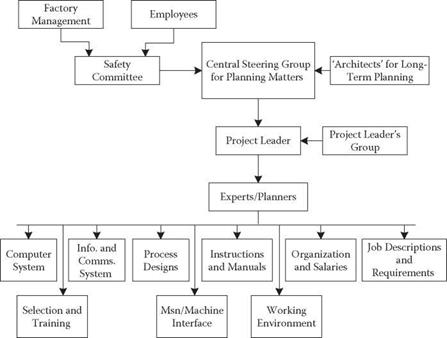Recently, there has been considerable emphasis on the rights of users to have an input into product/system development. To achieve an effective input from employees, it is necessary to establish an organisation for the planning work as a complement to the planning philosophy presented in Figure 13.1. This organisation is probably best determined in the company’s safety committee. Figure 13.3 shows one suggestion for how such an organisation might be set up for the development of a new, large system such as a new control system for a process.
A central steering group is needed for the project within the company. The steering group would include the safety committee and anyone in the company who has responsibility for long-term planning. The central steering group also includes a project leader who is directly responsible to it. There is, at the project leader’s disposal, a project leader’s group that includes representatives for the more important
|
FIGURE 13.3 Organisation chart of planning work. |
experts. This ‘expert group’ would include representatives of the operators affected and representatives for safety and company health functions, as well as the various technical specialists. The various experts and expert groups will work under the project leader. Among the experts and expert groups there should be special groups that deal with various personnel questions, for example, the production of job content analysis and job descriptions. Another group should be responsible for the selection and training programme, one for the instructions, manuals, and job aids, and one for organisational questions. If the project is a small one, some of these groups can be combined.
The central steering group decides upon and works out the goal analysis in conjunction with the project leader. Then the project leader, in coordination with the project leader’s group, carries out a suitable allocation of functions. This group also produces a preliminary proposal for function allocation. The proposal is then sent for consideration through the various groups in the company such as the safety committee and company management. Only after this stage can the central steering group decide on the first suitable allocation of functions. Any substantial changes from the first proposal for allocation of functions must again be discussed by the central steering group, which will then determine whether the approval of the various groups is again required. Figure 13.3 shows an organisation chart focusing on planning work.
As time is often short when the actual planning work gets started, a high proportion of the responsibility for the first part of the work (that is, that concerned with personnel and technology) lies with the project leader and the project leader’s group. Only the larger and more important matters are given to the central steering group. In order to have a last chance to assess whether the project shall be carried on to completion, a preliminary evaluation is made. This first major evaluation is made using a model or a pilot plant; if this is found to be impossible, drawings and progress charts can be used instead. The groups involved in dealing with personnel matters include employees’ representatives. These matters are also of concern to the central steering group and in the project leader’s group. It may also be desirable to include employees’ representatives in certain of the more critical technical groups.
Ergonomic and/or industrial psychology expertise is needed, for example, in the group working on the interface between the personnel and the technological system and equipment. Such special expertise may also be required in the groups working on instructions and manuals, in the finalising of the job descriptions, and also possibly on the production of a selection and training programme.




